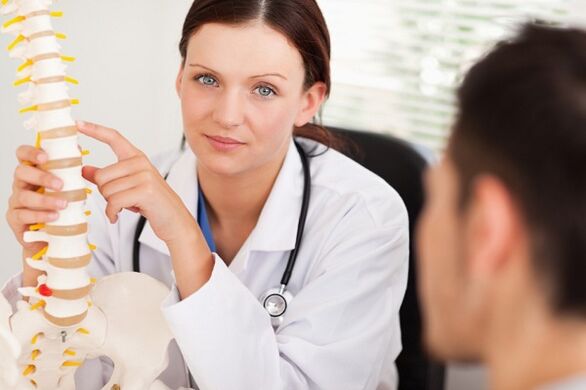Another serious disease of our time is osteochondrosis. The first activity can be seen at a young age, when sitting in front of a computer or notebook for a long time and suddenly start working in the driver's seat. Most find it difficult to turn or "get up" from the pillow. After a few days, the training generally passes, and it may take several months until the next arrival, and there may be a flight. Don't be fooled. The first thing is a serious warning that the mechanism of disruptive change in your organization has already begun. To understand this, let's understand what osteochondrosis is and why you should start treatment with the first symptoms.

What is osteochondrosis?
Osteochondrosis is the following dystrophic changes in the spine, and the following stages can be distinguished:
- Dystrophic changes in the cartilage tissue of the intervertebral discs, resulting in limited mobility and discomfort (stage I)
- Deformation of the discs and a gradual decrease in intervertebral distance (stage II).
- Herniated disc formation (stage III)
- Spinal formation (osteophytes) and ossification of ligaments make movement very difficult and painful (stage IV)
Hernia education is a difficult process that can be divided into all parts. But in the meantime, you should know that even if not treated in time, a serious illness will occur. Therefore, if you have a presentation of such a herd, let's explain it in two words. To do this, you need to return to the anatomy and remember the device of the spine and spinal disc.
Dystrophy of the spinal disc leads to weakening of the fibrous ring and displacement of the amber of the disc (nucleus).
To collide nalichie octeohondpoza, oCobenno nA pannih ctadiyah, kogda ne ickpivlenie daot open vneshnih ppiznakov, a oppzeleded ego nappavlennoct and ctepen, neobhodimo cdelat magnetno-side. This method of diagnosis, unlike X-rays, does not cause any harm to human health and allows you to accurately determine the angle. Based on the doctor's description and MPT images, the specialist will develop the right treatment plan that is safe and healthy for the patient.
Types of vertebral osteochondrosis
Osteochondrosis is divided into several types
- Cervical - the most common because it affects both young and old.
- Thoracic - relatively rare.
- Waist - develops after 40 years.
- Sacral - generally passes through the waist.
- Widespread - affects several branches or even the entire spine.
In the same sequence, the disease develops frequently and spontaneously: starting from the upper cervical vertebrae and ending with spontaneous and spontaneous.
However, it turns out that the type of osteochondrosis is associated with human activity. Thus, the cervix is generally spread among students, contractors and all other leaders of the "brain" professions, although some have long necks. - ppaltsyncecycity - ppaltsyncecyce picPectoral occultation is also observed in those who are on their feet almost all day, because the latter is kept on the ground in the middle of the war.
Causes of the appearance and development of osteochondrosis
However, osteochondrosis is not just the result of a sedentary lifestyle, improper posture or weight lifting. There are many causes and reasons for the onset of this disease.
Let's just mention the basics:
- An improper diet with enough protein and high sugar and fat.
- Metabolic disorders and hormonal imbalances.
- Infectious diseases.
- Hypothermia.
- Increased weight and obesity.
- Spinal cord injury.
- Age-related bone degeneration.
- Hereditary diseases.
- Stress.
The main symptoms of osteochondrosis
Cervical osteochondrosis:
- Neck and headache (may occur under scapula, sternum and arm).
- Dizziness, especially when changing the position of the head.
- Mismatch in the neck, face, tongue, subscapularis regions.
Chest osteochondrosis:
- Chest pain may increase with inspiration and movement.
- Feeling of numbness in the chest.
Lumbosacral:
- Pain in the lumbar region (which can be painful or sharp) spreads to the legs, and the localization of pain in the legs can move along the entire length of the joint.
- Paresis of the legs (impaired or even lost sensitivity).
Pain in osteochondrosis has a special neurological character. Thus, people perceive headaches, dizziness, numbness, or leg pain as a direct manifestation of head or foot disease, although they may be symptoms of vertebral osteochondrosis. Therefore, if you see anything in your health that coincides with the above symptoms, be sure to consult a neurologist. After the examination, the doctor will definitely order an X-ray examination if the disease is suspected.
The main methods of treatment of osteochondrosis
Before treating osteochondrosis, you must first eliminate the causes of its appearance.
The most effective treatment for back pain:
- Therapeutic gymnastics (exercises for back pain).
- MLS laser (pain disappears after the 2nd session).
- Khivamat (a unique procedure that immediately relieves pain, but you have to walk 2-3 times. )
Eliminating the causes of osteochondrosis is also the main way to treat and prevent it.

Prevention and non-drug treatment
This is primarily:
- Active (mobile) lifestyle and sports.
- A normal meal with a protein diet that excludes fats and sugars.
- Physiotherapy (exercise therapy) with a set of exercises selected individually for each type of osteochondrosis.
- Physiotherapy (magnetotherapy, ultrasound therapy, electrophoresis, laser therapy).
- Massage, textbook and reflexology.
However, such a conservative treatment is suitable for prophylaxis to prevent the development of osteochondrosis, not in the active period of the disease. However, how to treat this disease, if it persists, the manifestations are clear, and a person has an exacerbation stage, ie:
- pain and fever;
- limited, difficult movement.
In this case, exercise therapy and physiotherapy are strictly contraindicated, and only medications are used.
Drug treatment methods
First of all, it is necessary to stop the pain in the irritated nerve root and alleviate the inflammatory process. For this purpose, the following are appointed:
- non-steroidal anti-inflammatory drugs (NSAIDs);
- steroidal anti-inflammatory drugs - corticosteroids, glucocorticoids;
- novocaine blockade (with severe pain);
- drugs that relieve muscle spasms;
- ointments, gels and creams that relieve pain.
The second stage of treatment includes:
- Use of vasodilators: Osteochondrosis is always accompanied by vasoconstriction of the brain and oxygen starvation (hence headaches and dizziness).
- Prescribing drugs that calm the nervous system: Patients suffering from this disease are always anxious and suspicious, often very afraid of the first attacks of the disease.
- Treatment of concomitant events - may be hypertension and heart dysfunction.
- Treatment should be prescribed by a neurologist in the form of drops, injections and pills.
Do not try to cure the disease yourself!
At the end of the acute period and the normalization of well-being, return to non-pharmacological treatments: exercise therapy, massage and physiotherapy - in the absence of contraindications.
Cheers to you!
































